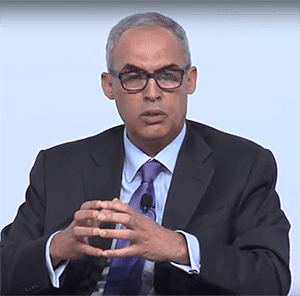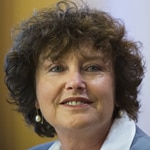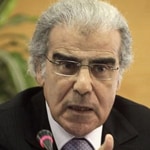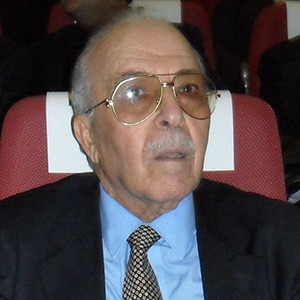These are the ratings for central bank governors from the Middle East and Africa regions in 2017.
For 23 years, Global Finance has been grading central bankers on how well they do their jobs. Our ratings are largely based on inflation control, economic growth, currency stability and interest-rate management. Other factors taken into account are central bankers’ skills in supervising financial institutions and their determination to protect their independence in the face of political pressure. For more on individual central bank governors, scroll below.
|
MIDDLE EAST & AFRICA |
|||
|---|---|---|---|
| Country | Central Bank Governor | 2017 | 2016 |
|
Algeria |
Mohamed Loukal |
B- |
Too early to say |
|
Angola |
Valter Filipe Duarte da Silva |
B- |
Too early to say |
|
Bahrain |
Rasheed Mohammed Al Maraj |
C |
B- |
|
Botswana |
Moses Pelaelo |
B+ |
B** |
|
DR Congo |
Deogratias Mutombo Mwana Nyembo |
C- |
N/A* |
|
Egypt |
Tarek Amer |
B+ |
C |
|
Ethiopia |
Teklewold Atnafu |
B |
B |
|
Ghana |
Ernest Addison |
Too early to say |
Too early to say** |
|
Iraq |
Ali Mohsen Ismail |
D |
C |
|
Israel |
Karnit Flug |
A |
A |
|
Jordan |
Ziad Fariz |
A- |
A- |
|
Kenya |
Patrick Njoroge |
B- |
B+ |
|
Kuwait |
Mohammad Yousef Al Hashel |
B+ |
B- |
|
Lebanon |
Riad Salameh |
A |
A |
|
Morocco |
Abdellatif Jouahri |
A |
A- |
|
Namibia |
Ipumbu Wendelinus Shiimi |
B- |
B |
|
Nigeria |
Godwin Emefiele |
D |
B- |
|
Oman |
Hamood Sangour Al Zadjali |
B |
B |
|
Qatar |
Abdulla Bin Saoud Al Thani |
B |
B |
|
Saudi Arabia |
Ahmed Alkholifey |
B+ |
Too early to say |
|
South Africa |
Lesetja Kganyago |
C |
B |
|
Tanzania |
Benno Ndulu |
C |
N/A* |
|
Tunisia |
Chédli Ayari |
B |
B |
|
Uganda |
Emmanuel Tumusiime-Mutebile |
C+ |
B- |
|
UAE |
Mubarak Rashed Al Mansoori |
B+ |
B+ |
| CENTRAL BANK GOVERNORS | MIDDLE EAST & AFRICA |
|---|
ALGERIA
Mohamed Loukal
GRADE: B-
Weak oil and gas prices are catching up with Algeria, which can no longer count on increased energy production to keep the economy growing. The Bank of Algeria has held its discount rate unchanged at 3.5% so far this year, with economic momentum slowing and inflation on the rise. Austerity measures and new taxes are dampening private consumption. The government is wary of moving too quickly to reform the welfare system. But it is unclear how long it can still draw on substantial reserves and increase borrowing to soften the blow of fiscal consolidation.
ANGOLA
Valter Filipe Duarte da Silva
GRADE: B-
With inflation dropping below 30%, its lowest in a year, the National Bank of Angola has kept its benchmark interest rate unchanged at 16%. The central bank said it is satisfied with the easing of consumer inflation and the steady exchange rate of the kwanza currency.
More than half of the population lives in poverty in Africa’s second-largest oil exporter after Nigeria. GDP growth last year was 1.1% and is unlikely to pick up much this year, due to weak domestic demand and difficult access to credit.

BAHRAIN
Rasheed Al Maraj
GRADE: C
Bahrain’s real GDP growth is expected to slow to 2.3% this year and 1.6% in 2018, reflecting fiscal consolidation and weaker investor sentiment, according to the International Monetary Fund.
Fiscal and external vulnerabilities have increased in the wake of the oil price decline. The IMF says additional sizable and frontloaded fiscal adjustment is “urgently needed” to reduce external financing needs. Debt is rising and reserves have fallen to dangerously low levels. Meanwhile, Central Bank of Bahrain has raised interest rates in lockstep with the US Federal Reserve to maintain its dollar peg.
BOTSWANA
Moses Pelaelo
GRADE: B+
Botswana is an African success story, with low and sustainable inflation and strong GDP growth in recent years. Overdependence on mining, however, has left the country vulnerable to mine closings. The economy’s growth slowed last year when copper and nickel mines shut down. Diamonds account for about 80% of the country’s exports. The Bank of Botswana has kept its official bank rate on hold at 5.5% so far this year. The central bank maintains a managed rate of exchange of the Botswanan pula against a basket of currencies.
DEMOCRATIC REPUBLIC OF CONGO
Déogratias Mutombo Mwana Nyembo
GRADE: C-
In February, Central Bank of Congo doubled its base interest rate to 14% from 7%, but by June the bank had to hike the rate again, to 20%, in an effort to stabilize the Congolese franc in the face of 36% inflation. DR Congo, Africa’s largest producer of both copper and cobalt, has been hit hard by low commodity prices. Central bank reserves fell below $1 billion—less than one month’s imports. That left the central bank with little choice but to raise rates or allow the currency to fall.
EGYPT
Tarek Amer
GRADE: B+
The Central Bank of Egypt raised its benchmark overnight deposit rate by 200 basis points in May and another 200 basis points in July, to 18.75%, as cuts in subsidies temporarily boosted inflation. The bank also hinted that the tightening cycle was over. After the floating of the Egyptian pound in November 2016, Egypt’s exports became more competitive and its current account deficit narrowed. The central bank said it is committed to maintaining a flexible exchange rate to cushion shocks and build up reserves.
ETHIOPIA
Teklewold Atnafu
GRADE: B
A severe drought continues in the Horn of Africa, but Ethiopia’s GDP growth is forecast at 8% this year, the strongest on the continent, according to the World Bank. The National Bank of Ethiopia has kept its benchmark interest rate unchanged at 5% for a second straight year. With a population over 104 million, second in Africa only to Nigeria, Ethiopia has strong domestic demand. Infrastructure investment is being funded by China, which recently completed the Addis Ababa–Djibouti Railway.
GHANA
Ernest Addison
GRADE: TOO EARLY TO SAY
The Bank of Ghana has chopped 550 basis points off its main policy rate so far this year, bringing it down to 21% in July, as inflation fell steadily but remained well above its 8% target. Addison was named governor in March, following the resignation of Nashiru Issahaku for personal reasons after only one year in the position. Addison previously was lead regional economist at the African Development Bank. He was director of research at the Ghana central bank from 2003 until 2011. GDP growth in the West African nation is picking up on a rebound in crude oil production.
IRAQ
Ali Mohsen Ismail
GRADE: D
Iraq’s weak financial system and inadequate economic data make it difficult for the central bank to conduct effective monetary policy. Political uncertainties and violence remain impediments to a sound economy, despite recent gains in the war on ISIS. Property rights are not protected, and tax revenues are minimal. The Central Bank of Iraq has kept its policy rate unchanged at 4% so far this year. Real GDP is expected to contract in 2017 by about 3%, due to a reduction of oil production. Ismail says the central bank aims to encourage economic growth with an initiative for financing small and medium enterprises.

ISRAEL
Karnit Flug
GRADE: A
Flug, the first female governor of the Bank of Israel, told a conference in June that a booming tech sector is leaving the rest of the Israeli economy behind. She said that domestic companies need more competition from abroad and that they should increase innovation. The bank’s monetary policy remains accommodative, with the benchmark interest rate holding at a record low 0.1% since March 2015. Inflation remains low, due in part to appreciation of the shekel. Currency intervention to slow the shekel’s gains has swelled the central bank’s reserves to $110 billion.
JORDAN
Ziad Fariz
GRADE: A-
With no oil and very little water or other natural resources, Jordan has maintained a moderate pace of economic growth. Real GDP growth of about 2.5% is likely this year, with tourist arrivals picking up and increased spending on infrastructure. The Central Bank of Jordan raised its policy rate by 25 basis points in June to 4.75%. This was its third increase, totaling a full percentage point for the year to date. With its exchange rate pegged to the dollar, Jordan closely follows increases in rates by the Federal Reserve. The higher rates in Jordan do not apply to the central bank’s refinancing programs for small and medium enterprises.
KENYA
Patrick Njoroge
GRADE: B-
Kenya’s largely market-based economy lost momentum last year following new rules capping bank lending rates. Credit growth to the private sector has slowed significantly. Yet the economy remains resilient, and Njoroge says banks should be satisfied with smaller profits. The Central Bank of Kenya has kept its bank rate unchanged at 10% so far this year. Although inflation rose to 11.5%, the bank expects food prices to ease after recent rains, which have eased drought conditions.
KUWAIT
Mohammad Yousef Al-Hashel
GRADE: B+
In June, the Central Bank of Kuwait refrained from following the Federal Reserve’s rate hike for the first time since 2015. The country’s oil sector has continued to shrink as a result of OPEC production cuts. Non-oil sectors of the economy are expanding, although at a slower rate than in recent years.
The Kuwaiti dinar is pegged to a basket of currencies dominated by the dollar. Kuwait had followed the Fed in three previous rate increases. The central bank said it declined to raise its discount rate in June because of low oil prices and a desire to support sustainable economic growth.
LEBANON
Riad Salameh
GRADE: A
Lebanon’s government reappointed governor Salameh in May for another six-year term, his fifth. The veteran central banker has maintained the country’s financial stability through some turbulent times. The Banque du Liban has kept its benchmark repo rate unchanged at 10% so far this year.
A stronger real estate sector and a rise in tourism have given a modest boost to the economy, with the World Bank projecting real GDP growth of 2.5% for 2017. The central bank has bolstered the country’s reserves and protected the value of the Lebanese pound.

MOROCCO
Abdellatif Jouahri
GRADE: A
A bumper agricultural harvest and rising phosphate exports could boost Morocco’s economic growth to 4.8% this year. The International Monetary Fund had nothing but praise for the country’s commitment to financial and structural reforms after a staff team visited in July. The IMF approved a $3.5 billion precautionary liquidity line for Morocco last year, but it has not been drawn upon.
Bank al-Maghrib, the central bank, is gradually moving toward a flexible exchange rate, which IMF analysts believe will allow the economy to better absorb external shocks and preserve the country’s competitiveness.
NAMIBIA
Ipumbu Shiimi
GRADE: B-
Forecasts by the central bank that Namibia’s economy would pick up this year seem to have fallen wide of the mark. The economy has tumbled into a recession as a result of its overdependence on the mining sector.
Recognizing the need for stimulus, the Bank of Namibia lowered its benchmark repo rate by 25 basis points in August, to 6.75%. The reduction was necessary to maintain the one-to-one link of the Namibian dollar with the South African rand. China has major investments in the country, and its Husab uranium mine in the Namib Desert is ready to start production.
NIGERIA
Godwin Emefiele
GRADE: D
Nigeria’s real GDP contracted by1.6% last year, marking the first full-year decline since 1991. Weak oil prices have continued to plague the economy, which is struggling to pull out of recession. Meanwhile, Central Bank of Nigeria has held its benchmark interest rate unchanged at 14% so far this year.
The monetary policy committee voted 6–2 in July for an unchanged policy, with two members favoring a rate cut, as inflation fell to 16.1%, the lowest in more than a year. The committee decided that monetary easing could undermine recent stability achieved in the foreign exchange market. Committee members are hoping that fiscal stimulus will boost the economy.
OMAN
Hamood Sangour Al Zadjali
GRADE: B
The Central Bank of Oman has allowed its official overnight repo rate to rise to 1.7% from 1.2% earlier this year, following rate increases by the Federal Reserve. The Omani currency, the rial, is pegged to the dollar.
The central bank has said the banking sector in Oman continues to witness reasonable growth in both credit and deposits, despite the overall slowdown in the economy as the result of low oil prices. Inflation in the first half of 2017 was 1.9%. The country has substantial foreign exchange reserves and is moving rapidly to diversify the economy.

QATAR
Abdulla Saud Al-Thani
GRADE: B
Qatar’s oil and gas exports do not appear to have been disrupted by the diplomatic crisis with its Arab neighbors, including Saudi Arabia and the United Arab Emirates. Qatar’s imports have fallen sharply, however, indicating a slowdown in economic activity. Local banks have compensated for liquidity shortfalls by borrowing from Qatar Central Bank’s repo facility. Qatar has $340 billion in its sovereign-wealth fund and an additional $40 billion of foreign exchange reserves. The country can continue tapping its reserves and borrowing abroad as it maintains a high level of infrastructure spending.
SAUDI ARABIA
Ahmed Alkholifey
GRADE: B+
The Saudi Arabian Monetary Authority (SAMA) raised its reverse repo rate by 25 basis points to 1.25% in June after the Federal Reserve raised rates. SAMA made similar increases following the Fed in March and in December 2016. However, the central bank kept its repo rate unchanged at 2%. Alkholifey said any impact of higher rates on domestic borrowers could be offset by appropriate liquidity measures. He noted that Saudi Arabia successfully defended the dollar peg in the late 1990s, when the kingdom had far fewer reserves.
SOUTH AFRICA
Lesetja Kganyago
GRADE: C
The South African Reserve Bank lowered its benchmark repo rate in July by 25 basis points to 6.75%, after the economy contracted in the first quarter and the inflation outlook improved somewhat. South Africa’s commodity-based economy is expected to grow only about 0.5% this year and 1% next year. The rand has been volatile and was not helped by proposed changes to the Reserve Bank’s monetary policy mandate to protect the value of the currency. Meanwhile, the central bank said in July that the growth outlook was deteriorating.
TANZANIA
Benno Ndulu
GRADE: C
The Bank of Tanzania lowered its discount rate by 400 basis points in March to 12%, after the International Monetary Fund said in January that the bank’s monetary policy should be eased to address a tight liquidity situation. Private sector credit growth has slowed following a sharp increase in nonperforming loans. Major foreign mining companies have reduced their operations in the country after the government raised taxes and demanded a higher share of the profits for Tanzanians.

TUNISIA
Chedly Ayari
GRADE: B
Weak economic growth, rising prices and high youth unemployment have plagued Tunisia since the Arab Spring uprisings. Central Bank of Tunisia raised its benchmark interest rate by a total of 75 basis points in March and April, to a five-year high of 5%, following an attack on the dinar currency. The bank said a widening trade deficit and increased government spending forced it to intensify its intervention in the market. Tunisia is moving forward with an IMF program that could force it to adopt a more flexible foreign exchange policy.
UGANDA
Emmanuel Tumusiime-Mutebile
GRADE: C+
The Bank of Uganda lowered the bank rate in steps, from 12% in January to 10% in August. The stable shilling and subdued consumer demand reduced inflation to 5.7%. Uganda is a landlocked East African country with a fast-growing population of over 41 million. Its largely agricultural economy has been hurt by drought and a reduction in exports to war-torn South Sudan. The country’s long-term growth could depend on the development of recently discovered oil reserves. High spending on infrastructure is necessary for this to happen, but may be unaffordable.

UNITED ARAB EMIRATES
Mubarak Rashed Al Mansoori
GRADE: B+
The Central Bank of the United Arab Emirates has raised its overnight repo rate from 1.5% to 2% so far this year, following hikes by the US Federal Reserve. The dirham currency is pegged to the dollar at a rate of 3.67 dirhams per greenback.
The oil sector has weakened recently on OPEC production cuts, although Dubai remains in an expansionary stance as it prepares for Expo 2020. The UAE has ample financial buffers; the Abu Dhabi Investment Authority is the largest sovereign-wealth fund in the region.



